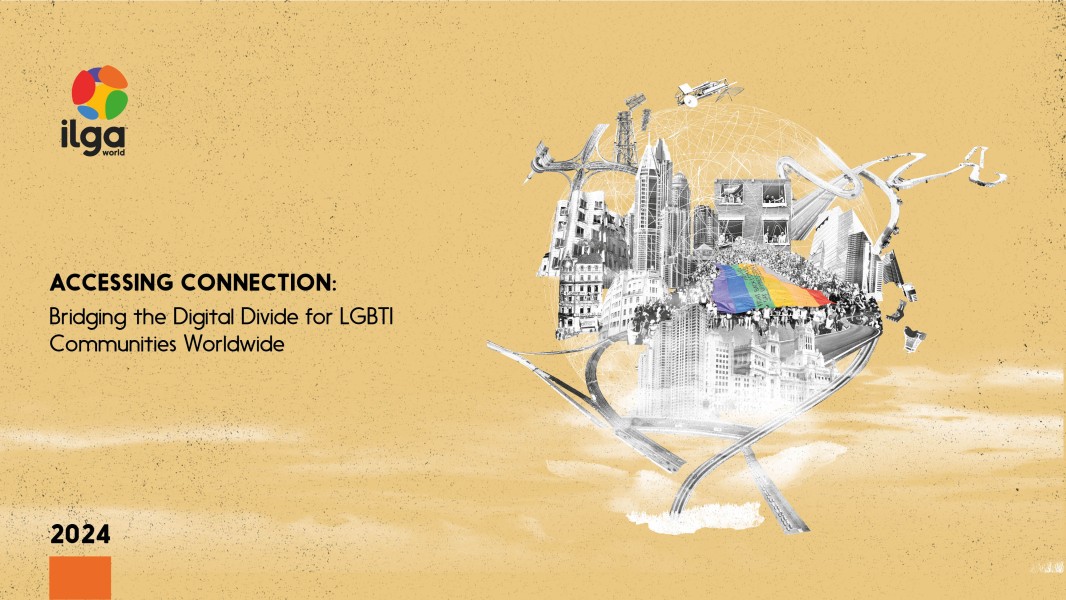NEW REPORT – Last week, in collaboration with ILGA World, our research on how the digital divide impacts LGBTI individuals and organisations globally was launched.
The report features stories from six organisations based in India (TARSHI), Uganda (HER Internet), Tonga (Tonga Leitis Association), the Netherlands (European Sex Workers’ Rights Alliance (ESWA)), Brazil (Colectivo LGBT do MST), and Jamaica (Transwave Jamaica).
We talked to LGBTI rights defenders in each of these organisations on how they navigate issues related to connectivity, digital security, digital literacy, surveillance and hostile policies that criminalise and silence LGBTI people and voices online.
Defining the digital divide
Access to the internet and digital inclusion are crucial in order for individuals to enjoy full political, social, and economic participation in society. To date, 2.6 billion people remain unconnected to the internet. The disparity in access and use of the internet is commonly referred to as the ‘digital divide.’ The digital divide entails access to the internet (affordability, connectivity and availability), utility of use (equipment, language access appropriate resources, accessibility), and the ability to use the internet safely (digital security and literacy).
Key findings
For LGBTI organisations, good access to the internet is essential
The internet has been an instrumental space for LGBTI communities and organisations to advocate, find community and resources, fundraise and to mobilise against harmful legislation. In some instances, organising and gathering online can also be safer than convening in person.
Overall, digital spaces provide an important avenue for visibility, in terms of both challenges faced and the important work LGBTI organisations are doing.
Cost is a key barrier to having access to technology and internet connectivity
Our interviewees overwhelmingly mentioned the unaffordability of devices, broadband and data as the biggest barrier to being able to access the internet. How affordable access is for LGBTI individuals depends on many factors, including geographic and socio-economic (some of the highest priced data packages, for example, are located in Africa).
Our research shows that many LGBTI people are impacted by factors like difficulties finding employment, harassment, societal stigma and hostile legislation, which can lead to economic precarity. This impacts an individual’s ability to purchase devices and afford adequate internet coverage.
At an organisational level, LGBTI organisations and organisations who work with or represent LGBTI people tend to be severely underfunded, which impacts the level of access to devices they are able to offer to their communities. Additionally, rural areas tend to be less connected than urban areas. Many of our interviewees are actively involved in promoting digital literacy and digital security training in rural localities, and emphasised the need for community support and capacity in this area.
There is a need for greater disability inclusion and digital accessibility
The report highlights the importance of inclusive design, language justice, and issues of online censorship as areas that must be addressed as part of bridging the digital divide.
LGBTI people with disabilities face access barriers due to a lack of inclusive design practices on online platforms, devices and applications.
Further, this research has identified issues of language accessibility, censorship, and content filtering as areas that impact people’s abilities to fully use sites and access information online. Interviewees noted that there is a need for more LGBTI specific resource generation in local languages that are available in accessible formats.
Online violence and harassment affects LGBTI people’s online participation
LGBTI communities are vulnerable to online violence and harassment. This violence can manifest as offline violence, such as physical and sexual abuse and stalking; in extreme cases, it can be life-threatening.
Cis and trans women, non-binary, gender-diverse, and intersex people face greater exposure to online violence and harassment. This is worsened by factors like misogynoir and racialised forms of violence.
These patterns of violence can lead women, girls and gender-diverse people to self-censor, leave platforms and sites, close online accounts, and participate less in the digital sphere. It can also result in more serious consequences of mental health detriments and offline violence.
Addressing and combating online violence is a key element of overcoming the LGBTI digital divide. This includes tactics like digital security training, increasing knowledge of laws that can be used to protect privacy, and greater advocacy around this issue.
Social and legal barriers limit LGBTI people’s full expression online
Growing anti LGBTI legislation and surveillance from governments and peers impacts LGBTI communities’ freedom of expression, and can result in self-censorship online, as well as offline harms such as arrests, detainment and harassment. In some regions, such as Southwest Asia and North Africa (SWANA), LGBTI people face issues of entrapment, blackmail, and abuse from the police as well as peers on dating apps and social media.
Hostile legislation that criminalises people of diverse sexual orientations, gender identities and expressions foster environments where people may fear posting on social media and/or accessing public wifi and media centres due to surveillance.
Recommendations
Our research found there is a need for greater data collection on the experiences of LGBTI individuals in reference to the digital divide. In particular, there is a need for more inclusive data collection on the gendered components of the digital divide which include trans and nonbinary people; as well as more exhaustive research on the experiences of intersex people in accessing and using the internet. Further, our interviewees identified the need for:
- increased solidarity across movements in combating anti-LGBTI legislation and protecting online privacy
- More funding
- increased disability inclusion and accessible digital design
- public policy in regards to internet funding and infrastructure
- education and awareness
- legal reforms.
We hope this report inspires more conversations, research and action on bridging the digital divide for LGBTI individuals and advocacy organisations.

